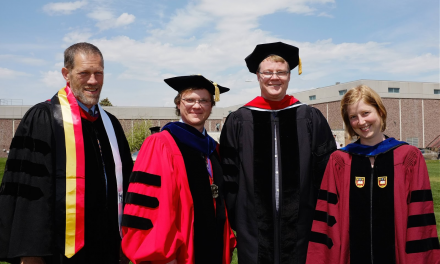This post is co-authored with Christopher McMahon.
The cost of colleges has been going up. This is not a surprise. It is disturbing, in part, because more and more people need a college degree to get by in today’s society. Several studies demonstrate that college graduates earn far more money, have better benefits, and enjoy greater job satisfaction than those who only have a high school diploma.
For Catholic colleges and universities, it is also disturbing as they must, in some way, shape or form, embody God’s commitment to the poor and vulnerable in society. Originally, Catholic colleges and universities in the United States arose to deal with immigrants and their integration into society. Now they find different ways to serve those in need in our society. It is no easy matter though, for even with the rise in tuition these institutions often struggle to pay the bills.
One of the key ways that colleges and universities have attempted to cut the rising costs of tuition is to cut “cost of instruction,” in other words, faculty salaries. Some argue for reducing the number of full-time faculty positions, and others want to get rid of faculty altogether. A closer look at the overall costs associated with higher education, however, reveal that increases in faculty salaries have not been the primary culprit. Faculty numbers have kept pace with student enrollment. Moreover, full-time faculty members have more and more been replaced with adjunct faculty, who are then paid a set stipend far below the full-time salary and are ineligible for health benefits and retirement. It keeps the actual “cost of instruction” down.
The rise in the “cost of administration” has had a much bigger impact on tuition costs. The number of administrators has far outpaced that of rising student enrollments by over 200%. In fact, as the number of full-time faculty members has decreased, the ranks of administrators have increased by 28%. For every 1 faculty member there are 2.5 administrators. Also,
In his book on administrative bloat, The Fall Of The Faculty, Johns Hopkins professor Benjamin Ginsberg reports that although student-faculty ratios fell slightly between 1975 and 2005, from 16-to-1 to 15-to-1, the student-to-administrator ratio fell from 84-to-1 to 68-to-1, and the student-to-professional-staff ratio fell from 50-to-1 to 21-to-1. Ginsberg concludes: “Apparently, when colleges and universities had more money to spend, they chose not to spend it on expanding their instructional resources, i.e. faculty. They chose, instead, to enhance their administrative and staff resources.
In order to save money, we think that the time has come to adopt an approach to administration that mirrors the growing trend in the area of instruction: we need to hire adjunct administrators. This move would greatly reduce the cost of colleges and universities. Administrators would not be full-time but just receive a stipend for whatever task they were hired to complete. Just think . . . .
- Colleges could hire adjunct administrators to run meetings. They would be more professional and efficient, and there would be fewer of them, as the institution would have to pay for each meeting.
- Twice a year, institutions could hire an adjunct administrator to put together the schedule of classes.
- At the end of each semester, the adjunct administrator could complete assessment reports.
- Every five years, one could hire an adjunct administrator to craft a strategic plan.
- Every ten years, an adjunct administrator could be hired on a fee-for-service basis to run the reaccreditation steering committee.
- There could be an adjunct administrator to perform all the ceremonial functions of standing on stage, and perhaps even adjunct “speech-givers”.
- Those who work in institutional advancement could just work on commission as “adjunct fundraisers.” This would incentivize them to bring in more money.
Imagine the potential savings! There would be no large salaries or benefits to pay to administrators. There would be no expectation of ongoing employment, so, if an administrator asked for more money or gets too old, institutions could just move on to hire someone new (or more congenial)!
Some might argue that only competitive salaries will attract the best people in administration. Additionally, some might say that people in the Office of Institutional Advancement need to have a deep commitment and a familiarity with the institution in order to be effective fundraisers over the long haul, or that those who represent the college in public ought to have a deep and lived knowledge of the community of scholars they represent. Moreover, institutional decisions should be made by long-term employees who have significant institutional ties and commitments. But are these concerns enough to outweigh the potential economic benefits? Maybe we should ask the adjunct professors their opinion.






Trackbacks/Pingbacks